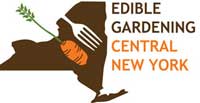YOU can be a part of Onondaga Lake's Habitat Restoration
Sat. Aug. 11
9 am - noon | |
| |
Be an environmental steward,
enhance habitat, support birding, and
help preserve our watershed.
Activities will include planting native shrubs and plants,
conducting stream samplings, and learning from habitat experts. Rain or shine. Lunch will be provided. Here's more information about this event. Space is limited! RSVP at montezuma@audubon.org with "Onondaga Lake" in the subject line or call 315-365-3588 by August 6. |
Learn about the birds
in your backyard
Thurs. Aug. 16
11:00 am - noon |
 | |
Black-capped chickadee
|
| |
Frank Moses of the Montezuma Audubon Center will introduce us to our feathered friends living in our backyard and by Onondaga Lake.
FREE! Appropriate for all ages over 3 years.
Solvay Public Library
615 Woods Rd. Solvay
315.468.2441
|
| Skaneateles Lake Watershed Events |  |
Ecological Impacts of Home Landscaping Practices Aug. 9, 5:00 pm - 6:30 pm
The Creamery, 28 Hannum St. Skaneateles
iMapInvasive Workshop Aug. 14, 5:30 pm - 7:00 pm Skaneateles Library 46 E. Genesee St. Skaneateles
Asian Clam and Hydrilla Identification, Prevention, and Monitoring Workshop Aug. 22, 6:00 pm - 7:30 pm Skaneateles Community Center 97 State St.., Skaneateles
Forest Management and Invasive Insect Workshop Aug. 28, 5:00 pm - 6:30 pm The Creamery 28 Hannum St. Skaneateles
Septic and Well Water Workshop Sept. 12, 5:30 - 7:00 pm United Methodist Church 26 Jordan St., Skaneateles
Funding for these events is provided by the City of Syracuse Dept. of Water
For details and to register visit www.extendonondaga.org or contact Sherry Martin at 315.424.9485 ext. 232, sm674@cornell.edu |
| Our Habitat Garden |  |
Visit Our Habitat Garden website for information on providing habitat, earth-friendly gardening practices, plants, and various creatures here in Central New York.
|
|
Join HGCNY!
|  |
Becoming an official member of HGCNY is easy: just join Wild Ones! When you're a Wild Ones member, you're automatically an official member of HGCNY. |
| HGCNY on Facebook |
As as more of us participate on our Facebook page, this will become a useful resource for asking (and answering!) local HGCNYers' questions about habitat gardening. |
| Interested in Edible Gardening? | 
|
If you'd like to get information on Edible Gardening CNY, just email John to find out about edible gardening tours and monthly programs. Free and open to the public! |
|
Our Edible Garden: updated with GROUNDHOG info!
|  | Visit OurEdibleGarden.org to see an example of a Central New York edible garden, the perfect companion to your habitat garden.
Here's our experiences with groundhogs, and here's our solution to the groundhog problem!
|
|
Greetings!
 | | Tour a habitat garden |
Show Me, Help Me Tours
Summer is time to explore our fellow HGCNYers' gardens. We have a number of tours scheduled. They're all free and open to the public.
AUGUST
Sun. Aug. 5 at 8:30 am:
We'll tour Chris's garden (I81 Cicero exit, just off Route 11). It's about a third of an acre, and she's in the process of planting it as an edible and a habitat garden. She's willing to dig herbs for people that morning! She has made a lot of progress, but could use help with native ID and would welcome ideas about what to plant. Please RSVP to Chris for directions; limited to 15 people, but there's still space available! Sun. Aug. 19 at 2:00 pm: We'll tour Linda Rossiter's wooded property in a residential area in Fulton. It's just under a half-acre and borders a Class II wetland with stream. The gardens--including some deep shade and part-shade gardens--are being transitioned towards all native plants. Bring binoculars to view the marsh, and bring boots if you'd like to go into the marsh. Joe-pye weed, boneset, goldenrod should all be in full bloom! Linda would like help with plant ID and suggestions for new plants to add. RSVP to Linda for directions.
~ Janet Allen
|
|
 | | Sweet coneflower (Rudbeckia subtomentosa) |
Go Botany
Have you ever been frustrated trying to identify a plant?
The New England Wildflower Society has developed a handy online tool to help you sort through all the possibilities.
It's called Go Botany, and it has been developed to help everyone from school children on up identify plants. Of course, it has been designed specifically for plants found in New England, but many if not most of the plants will also be found in New York, so it will be useful for us, too.
As with many plant identification books, its purpose is to help you identify plants--any plant you encounter. Some of these will not be native, but you'll still want to identify them.
Here's a short video tutorial that helps get you started using this tool. |
 | |
One of our nation's useless lawns
|
Turf grass
Here are some facts about turf grass from "Your Yard is Evil," a funny 3-1/2 minute video:
* There is 3 times more irrigated turf grass than corn in the US
* Almost all of the water used to water our lawns is potable
* 30% of our fresh water is used to water lawns
* We apply 70 million pounds of pesticides a year on lawns
A funny video, but not so funny facts!
Reduce your lawn this year
With the heat and drought this year, turf grass isn't at its healthiest. This fall would be a great time to convert some of it to native plants and edible gardens!
More information on lawns
EPA: Outdoor water use
Green Grok: Lawns by the numbers
EPA: Green landscaping
|
|
Share a photo of your Monarch Waystation
 | | Monarch Waystation sign |
If you have milkweeds, nectar plants, and refrain from using pesticides, you're helping monarch butterflies survive, and you may even have an official Monarch Waystation.
If you've met the Monarch Watch requirements for providing for the monarch's needs, you can become certified and are eligible to purchase a sign. (Note: Monarch Watch includes non-natives on their plant list, but we suggest natives instead!)
If you have a certified Waystation, send a digital photo, and we'll create a page on our HGCNY website showing the Monarch Waystations in CNY.
Please include your Waystation number and how you would like to be identified (e.g. "Syracuse," "Sam from Syracuse," "Sam Smith at 100 Main St., Syracuse," etc.--whatever level of specificity you're comfortable with).
You're also welcome to include a brief paragraph indicating what kind of milkweed and other native nectar plants are in your Waystation and any other information of interest.
Our first Waystation The Women's Garden Club of Baldwinsville submitted our first Monarch Waystation, Yevich Trail! |
 Saturday Aug. 11:
The Great Bee Count
The Great Sunflower Project invites everyone across the U.S. to join in the Great Bee Count.
From The Great Sunflower Project:
Even if you do not have blooms on your sunflowers by August 11th, you can still be enjoy, learn and be part of the project by observing bees on other plants that you may have in bloom.
Cosmos, tickseed (coreopsis), bee balm (monarda; Oswego tea) and echinacea (purple coneflower), are all on our list, so you can collect data on these if your sunflowers are not blooming yet.
And, it's okay if your sunflower hasn't bloomed yet. They will in time so you can make your 15 minute observation when they do open up.
This year, in support of the Great Bee Count, YourGardenShow.com will present a special online live broadcast "Double Feature" on August 11th, from 10am - noon EST (7am to 9am PST). First hour: a special "Ask Ian" Q&A show about pollination and pollinators followed by an hour of moderated interviews with bee experts talking about our pollinator friends. Join us for this one day event.
What has been learned so far?
See the results of the data citizen scientists have collected over the past few years.
Here are just a few of the results:
* Larger gardens have higher pollinator service (average bee visits in an hour) but even small gardens do well.
* Shady sites have lower visitation rates than sunny sites
* Urban areas have the least pollination services; rural and wildlands have the most
|
|
Our Native Plant Shopping Guide tells you where to find native plants
 | |
(Click image to download)
|
To help you find native plants in CNY, we've compiled a list of plants offered by several local nurseries. REMEMBER, nurseries can sell out of any particular plant, so it's a good idea to call before setting out on your shopping trip! DOWNLOAD: This guide is available online as a free .pdf download. |
|
|
|
|